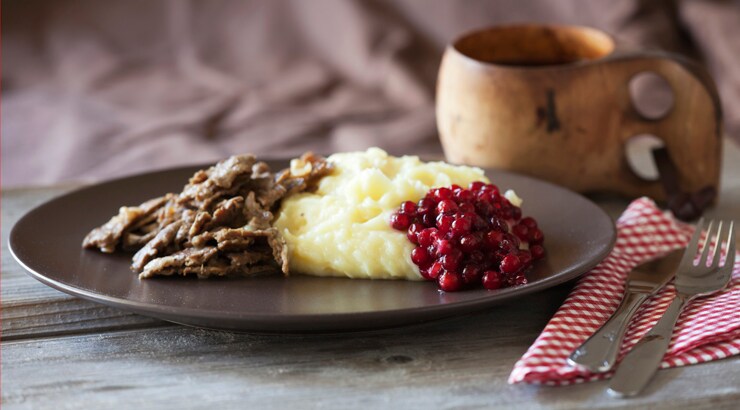Finland, to me, means Finnish Lapland and therefore the Santa Claus Village in Rovaniemi.
I’ve always dreamed of visiting it, but the high costs of such a trip have prevented me from doing so until now. However, if one day I manage to fulfill this childhood desire, I would also like to taste one of the most famous Finnish specialties: the poronkaristys, which seems a bit at odds with my intention to visit Santa Claus, since it is… reindeer stew.
Reindeer is poronkäristys in Finnish; it is a typical stew from the northern regions of Finland, especially in Lapland.
Extremely popular on Finnish tables, reindeer has tender meat that pairs well with red wine, beer, mashed potatoes and lingonberry sauce.
The meat is slowly cooked with onion, butter, broth, and beer or water, and uses lard for extra richness.
Reindeer meat is said to have a distinctive flavor and can be too strong if not accompanied by some sauce or side dish.
Its flavor might remind Italians of the strong tastes of game.
Reindeer farming in Finland is widespread mainly in Lapland, and large quantities of reindeer meat are consumed by the Finnish people (about 2.5 million kilos each year).
The difficulty here is finding reindeer meat, which I could only find online.

- Difficulty: Easy
- Cost: Very Expensive
- Preparation time: 5 Minutes
- Portions: 6 people
- Cooking methods: Stovetop
- Cuisine: European
- Seasonality: All seasons
Ingredients for poronkaristys:
- 2.2 lbs reindeer meat
- 5.3 oz butter (or reindeer fat or lard)
- 1.25 cups beef broth (or hot water)
- 0.4 cup dark beer
- 2 onions
- to taste salt and pepper
Preparation of poronkaristys:
In a clay pot, melt the butter (the original recipe would require reindeer fat, which is impossible to find in Italy, or lard), and in the meantime, cut the meat into pieces, then add it to the butter.
Let it heat up and fry for about 10 minutes.
Add the finely chopped onions to the meat and cook until they become soft and transparent.
Pour in the beef broth (or water) and the beer. Add salt and pepper as well.
Cover the pan and let it simmer for about 1-1.5 hours, or until the meat becomes tender. During cooking, if necessary, add more broth or water.Serve on a plate, making a well in the base of mashed potatoes, place the meat in it, and add the lingonberry sauce (puolukka) next to it (mix fresh lingonberries and sugar and let it rest).
Pairing with drinks:
In Italy, one might pair poronkaristys with an important red wine like Montepulciano or Valpolicella Ripasso, but no wine is produced in Finland.
The proposal is to pair it with a beer: Norwegian Wood.
It is a smoked beer.
It is a smoked beer.
It is a smoked beer.
Playmobil- Christmas Toy Santa’s Oven with Cookie Molds for Kids
What is the name of the lingonberry sauce?
Puolukka is the Finnish term for lingonberry, and puolukkahillo is the lingonberry sauce or jam made with these berries.
In Finland, puolukkahillo is a traditional accompaniment for many dishes, including Poronkaristys, but also on pancakes, toast, or desserts, where the contrast between the savory flavor of the meat and the sweet-tart of the lingonberry sauce creates a delicious pairing.
Recipe
Ingredients:
500 g of fresh lingonberries (you can also use frozen lingonberries)
250 g of sugar (you can adjust the amount based on desired sweetness)
100 ml of water
Method:
If using fresh lingonberries, wash them well and remove any twigs or debris.
If using frozen lingonberries, there is no need to thaw them before cooking.
In a pot, add the lingonberries, water, and lemon juice (if desired). Bring to a boil and let cook over medium-low heat for about 10-15 minutes, stirring occasionally.
During cooking, the lingonberries will break down and release their juice, creating a sort of puree.
Add the sugar and mix well until completely dissolved.
Let the mixture cook for another 10 minutes or so, until it thickens. You can adjust cooking based on desired consistency: if you prefer a thicker sauce, cook for longer; if you want it more liquid, stop earlier.
To check if the sauce is ready, take a teaspoon of the mixture and place it on a cold saucer. Allow it to cool for a minute and then tilt the saucer. If the sauce thickens, it is ready.Are the lingonberries or cranberries used for the sauce?
Lingonberries (called puolukka in Finnish) and cranberries are very similar, but not exactly the same.
Lingonberries (or lingonberries in English) are the fruits commonly used to make puolukkahillo in Finland. These berries are a bit smaller and have a sweeter, less acidic taste compared to cranberries. They grow mainly in northern environments such as Scandinavia, Russia, and Canada.
Cranberries (or Vaccinium macrocarpon) are another type of berry, but they grow primarily in North America. They have a decidedly more acidic flavor compared to lingonberries and are often used to make juices or jellies.
So, when making puolukkahillo (lingonberry sauce), in Finland lingonberries (lingonberries) are used, not cranberries.

